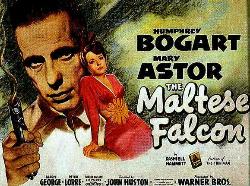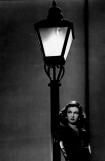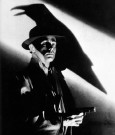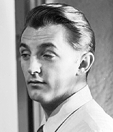Film Noir
 Film noir is term coined
by French critics to describe a type of film that is characterized by its dark,
somber tone and cynical, pessimistic mood. Literally meaning dark (or
black) film, the term alludes to the hard-boiled detective novels
and thrillers published during the 1930s in a series entitled the roman noir.
Specifically, film noir was coined to describe those Hollywood films
of the '40s and early 50s which portrayed the dark and gloomy underworld of
crime and corruption, films whose heroes as well as villains are cynical, disillusioned,
and often insecure loners, unable to escape the past and unsure or apathetic
about the future. In terms of style and technique, the film noir favors
night scenes, both interior and exterior, with sets that suggest dingy realism,
and with lighting that emphasizes deep shadows and accents the mood of fatalism
and entrapment. The dark tones and the tense nervousness are complemented by
the oblique choreography of the action and the doom-laden compositions and camera
angles.
Film noir is term coined
by French critics to describe a type of film that is characterized by its dark,
somber tone and cynical, pessimistic mood. Literally meaning dark (or
black) film, the term alludes to the hard-boiled detective novels
and thrillers published during the 1930s in a series entitled the roman noir.
Specifically, film noir was coined to describe those Hollywood films
of the '40s and early 50s which portrayed the dark and gloomy underworld of
crime and corruption, films whose heroes as well as villains are cynical, disillusioned,
and often insecure loners, unable to escape the past and unsure or apathetic
about the future. In terms of style and technique, the film noir favors
night scenes, both interior and exterior, with sets that suggest dingy realism,
and with lighting that emphasizes deep shadows and accents the mood of fatalism
and entrapment. The dark tones and the tense nervousness are complemented by
the oblique choreography of the action and the doom-laden compositions and camera
angles.
 Hollywood productions of the film noir
style include: John Huston's The Maltese Falcon (1941) and The Asphalt
Jungle (1950), Howard Hawks's To Have And Have Not (1944) and The
Big Sleep ( 1946), Michael Curtiz' s Casablanca (1942), Tay Garnett's The
Postman Always Rings Twice (1946), Billy Wilder's Double Indemnity
(1944) and Sunset Boulevard (1950), Fritz Lang's The Big Heat
(1953), Alfred Hitchcock's Strangers on a Train (1951); Rudolph Maté's
D.O.A. (1950), Henry Hathaway's Kiss Of Death (1947), Nicholas
Ray's They Live By Night (1949), Sam Fuller's Pickup On South Street
(1953), and Robert Aldrich's Kiss Me Deadly (1955).
Hollywood productions of the film noir
style include: John Huston's The Maltese Falcon (1941) and The Asphalt
Jungle (1950), Howard Hawks's To Have And Have Not (1944) and The
Big Sleep ( 1946), Michael Curtiz' s Casablanca (1942), Tay Garnett's The
Postman Always Rings Twice (1946), Billy Wilder's Double Indemnity
(1944) and Sunset Boulevard (1950), Fritz Lang's The Big Heat
(1953), Alfred Hitchcock's Strangers on a Train (1951); Rudolph Maté's
D.O.A. (1950), Henry Hathaway's Kiss Of Death (1947), Nicholas
Ray's They Live By Night (1949), Sam Fuller's Pickup On South Street
(1953), and Robert Aldrich's Kiss Me Deadly (1955).
The film noir
trend, which had been influenced by a combination of factors, including an influx
of immigrant directors from central Europe and the sobering effects of WWII
and its aftermath, had all but run itself out by the mid-50s. But isolated films
in the style continued to be made in Hollywood for some years, among them Stanley
Kubrick's The Killing (1956), Welles's Touch Of Evil (1958), Don
Siegel's Dirty Harry (1971), Robert Altman's The Long Goodbye
(1973), and Roman Polanski's Chinatown (1974).
 A revival of interest in film noir
in the '80s brought a spate of films attempting to recapture the style Some
good examples of this renewed interest can be seen in Lawrence Kasdan's Body
Heat (1981), Ridley Scott's Blade Runner (1982) and Thelma and
Louise (1991), Joel Coen's Blood Simple (1984), John Dahl's Kill
Me Again (1989), Dennis Hopper's The Hot Spot (1990), Steven Frears's
The Grifters (1990), and Kenneth Branagh's Dead Again (1991),
Brian Singer's The Usual Suspects (1995), and David Fincher's Se7en
(1995).
A revival of interest in film noir
in the '80s brought a spate of films attempting to recapture the style Some
good examples of this renewed interest can be seen in Lawrence Kasdan's Body
Heat (1981), Ridley Scott's Blade Runner (1982) and Thelma and
Louise (1991), Joel Coen's Blood Simple (1984), John Dahl's Kill
Me Again (1989), Dennis Hopper's The Hot Spot (1990), Steven Frears's
The Grifters (1990), and Kenneth Branagh's Dead Again (1991),
Brian Singer's The Usual Suspects (1995), and David Fincher's Se7en
(1995).
During the same period
a number of film noir classics were remade, among them Bob Rafelson's
The Postman Always Rings Twice (1981), Taylor Hackford's Against All
Odds (1984), Rocky Morton and Annabel Jankel's D.O.A. (1988), Irwin
Winkler's Night And The City (1992), and Barbet Schroder's Kiss of
Death (1995).
The term film noir
was also applied to certain French films of WWII and the postwar years and later
to films of the New Wave which were influenced by the Hollywood crime movies.
In its broader sense, the term has been used retroactively to describe expressionist
German films of the '20s and Hollywood's gangster picture cycle of the '30s.
 Today the film noir is one of
the most influential and admired film genres. Its conventions have been widely
used by contemporary filmmakers, and the films we will see in this course testify
to that influence. Moreover, the genre has been both popular and highly regarded
by film critics and historians. To learn more about the film noir, try
browsing these internet sites: the many titles listed together at the Internet
Movie Database and the collections of criticism and images at The Raymond Chandler Library,
Martin's Film Noir Page, and
the Film
Noir Web Links.
Today the film noir is one of
the most influential and admired film genres. Its conventions have been widely
used by contemporary filmmakers, and the films we will see in this course testify
to that influence. Moreover, the genre has been both popular and highly regarded
by film critics and historians. To learn more about the film noir, try
browsing these internet sites: the many titles listed together at the Internet
Movie Database and the collections of criticism and images at The Raymond Chandler Library,
Martin's Film Noir Page, and
the Film
Noir Web Links.
 Film noir is term coined
by French critics to describe a type of film that is characterized by its dark,
somber tone and cynical, pessimistic mood. Literally meaning dark (or
black) film, the term alludes to the hard-boiled detective novels
and thrillers published during the 1930s in a series entitled the roman noir.
Specifically, film noir was coined to describe those Hollywood films
of the '40s and early 50s which portrayed the dark and gloomy underworld of
crime and corruption, films whose heroes as well as villains are cynical, disillusioned,
and often insecure loners, unable to escape the past and unsure or apathetic
about the future. In terms of style and technique, the film noir favors
night scenes, both interior and exterior, with sets that suggest dingy realism,
and with lighting that emphasizes deep shadows and accents the mood of fatalism
and entrapment. The dark tones and the tense nervousness are complemented by
the oblique choreography of the action and the doom-laden compositions and camera
angles.
Film noir is term coined
by French critics to describe a type of film that is characterized by its dark,
somber tone and cynical, pessimistic mood. Literally meaning dark (or
black) film, the term alludes to the hard-boiled detective novels
and thrillers published during the 1930s in a series entitled the roman noir.
Specifically, film noir was coined to describe those Hollywood films
of the '40s and early 50s which portrayed the dark and gloomy underworld of
crime and corruption, films whose heroes as well as villains are cynical, disillusioned,
and often insecure loners, unable to escape the past and unsure or apathetic
about the future. In terms of style and technique, the film noir favors
night scenes, both interior and exterior, with sets that suggest dingy realism,
and with lighting that emphasizes deep shadows and accents the mood of fatalism
and entrapment. The dark tones and the tense nervousness are complemented by
the oblique choreography of the action and the doom-laden compositions and camera
angles. Hollywood productions of the film noir
style include: John Huston's The Maltese Falcon (1941) and The Asphalt
Jungle (1950), Howard Hawks's To Have And Have Not (1944) and The
Big Sleep ( 1946), Michael Curtiz' s Casablanca (1942), Tay Garnett's The
Postman Always Rings Twice (1946), Billy Wilder's Double Indemnity
(1944) and Sunset Boulevard (1950), Fritz Lang's The Big Heat
(1953), Alfred Hitchcock's Strangers on a Train (1951); Rudolph Maté's
D.O.A. (1950), Henry Hathaway's Kiss Of Death (1947), Nicholas
Ray's They Live By Night (1949), Sam Fuller's Pickup On South Street
(1953), and Robert Aldrich's Kiss Me Deadly (1955).
Hollywood productions of the film noir
style include: John Huston's The Maltese Falcon (1941) and The Asphalt
Jungle (1950), Howard Hawks's To Have And Have Not (1944) and The
Big Sleep ( 1946), Michael Curtiz' s Casablanca (1942), Tay Garnett's The
Postman Always Rings Twice (1946), Billy Wilder's Double Indemnity
(1944) and Sunset Boulevard (1950), Fritz Lang's The Big Heat
(1953), Alfred Hitchcock's Strangers on a Train (1951); Rudolph Maté's
D.O.A. (1950), Henry Hathaway's Kiss Of Death (1947), Nicholas
Ray's They Live By Night (1949), Sam Fuller's Pickup On South Street
(1953), and Robert Aldrich's Kiss Me Deadly (1955). A revival of interest in film noir
in the '80s brought a spate of films attempting to recapture the style Some
good examples of this renewed interest can be seen in Lawrence Kasdan's Body
Heat (1981), Ridley Scott's Blade Runner (1982) and Thelma and
Louise (1991), Joel Coen's Blood Simple (1984), John Dahl's Kill
Me Again (1989), Dennis Hopper's The Hot Spot (1990), Steven Frears's
The Grifters (1990), and Kenneth Branagh's Dead Again (1991),
Brian Singer's The Usual Suspects (1995), and David Fincher's Se7en
(1995).
A revival of interest in film noir
in the '80s brought a spate of films attempting to recapture the style Some
good examples of this renewed interest can be seen in Lawrence Kasdan's Body
Heat (1981), Ridley Scott's Blade Runner (1982) and Thelma and
Louise (1991), Joel Coen's Blood Simple (1984), John Dahl's Kill
Me Again (1989), Dennis Hopper's The Hot Spot (1990), Steven Frears's
The Grifters (1990), and Kenneth Branagh's Dead Again (1991),
Brian Singer's The Usual Suspects (1995), and David Fincher's Se7en
(1995). Today the film noir is one of
the most influential and admired film genres. Its conventions have been widely
used by contemporary filmmakers, and the films we will see in this course testify
to that influence. Moreover, the genre has been both popular and highly regarded
by film critics and historians. To learn more about the film noir, try
browsing these internet sites: the many titles listed together at the
Today the film noir is one of
the most influential and admired film genres. Its conventions have been widely
used by contemporary filmmakers, and the films we will see in this course testify
to that influence. Moreover, the genre has been both popular and highly regarded
by film critics and historians. To learn more about the film noir, try
browsing these internet sites: the many titles listed together at the